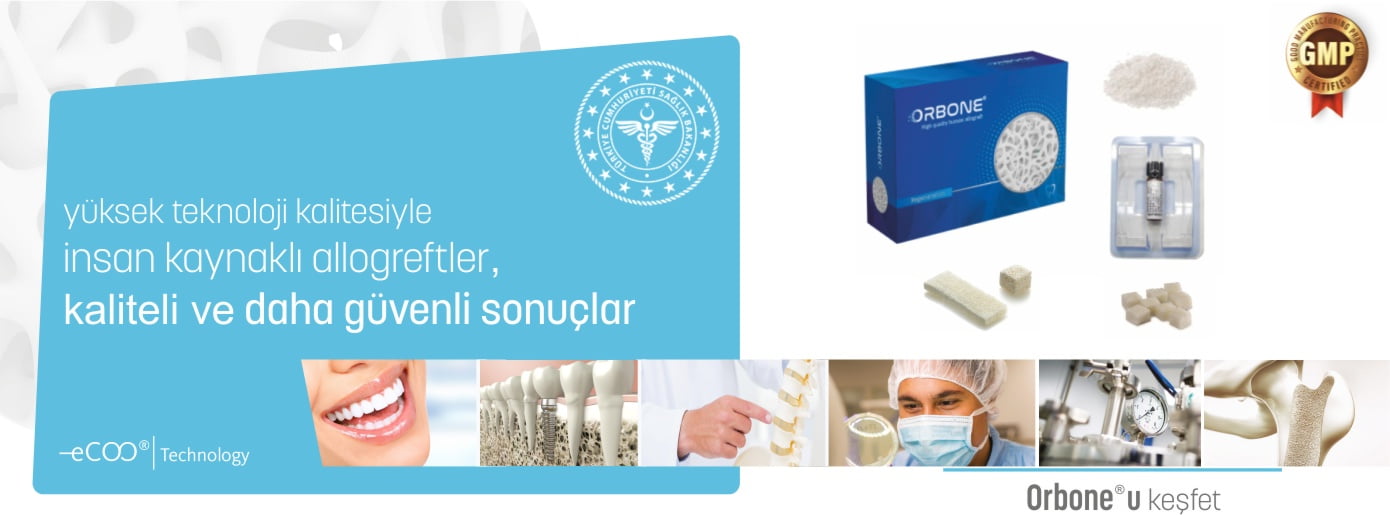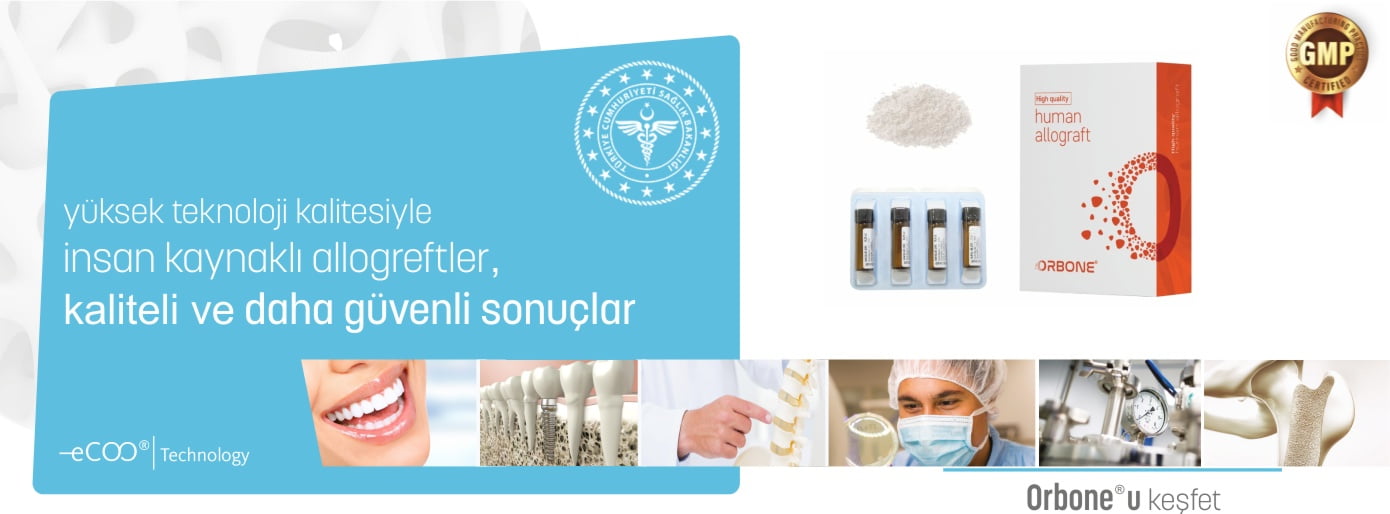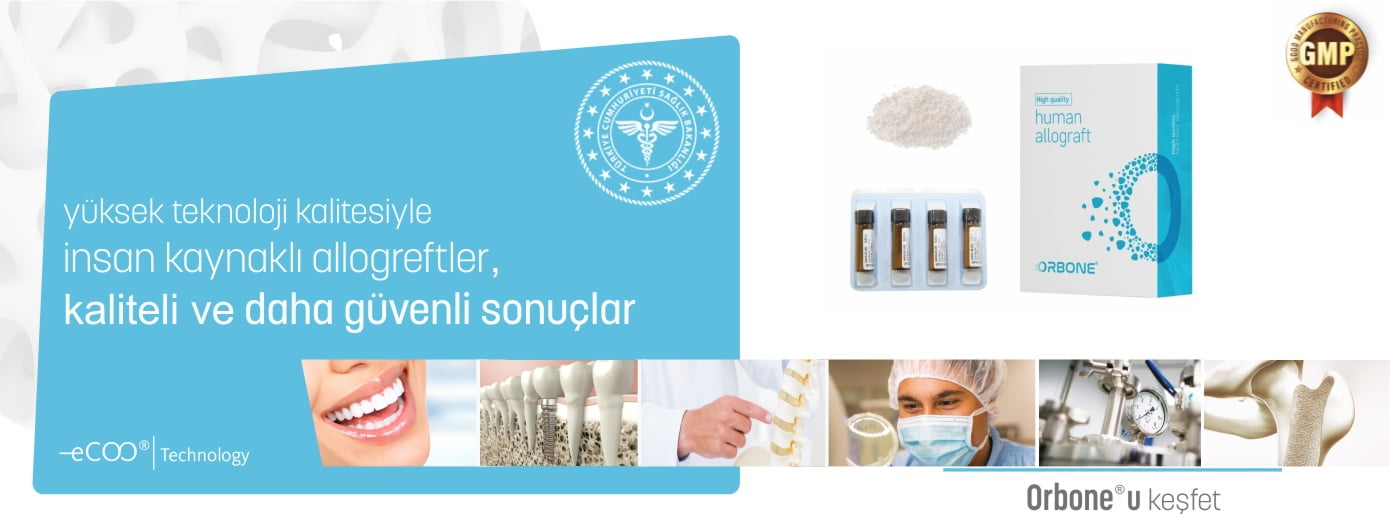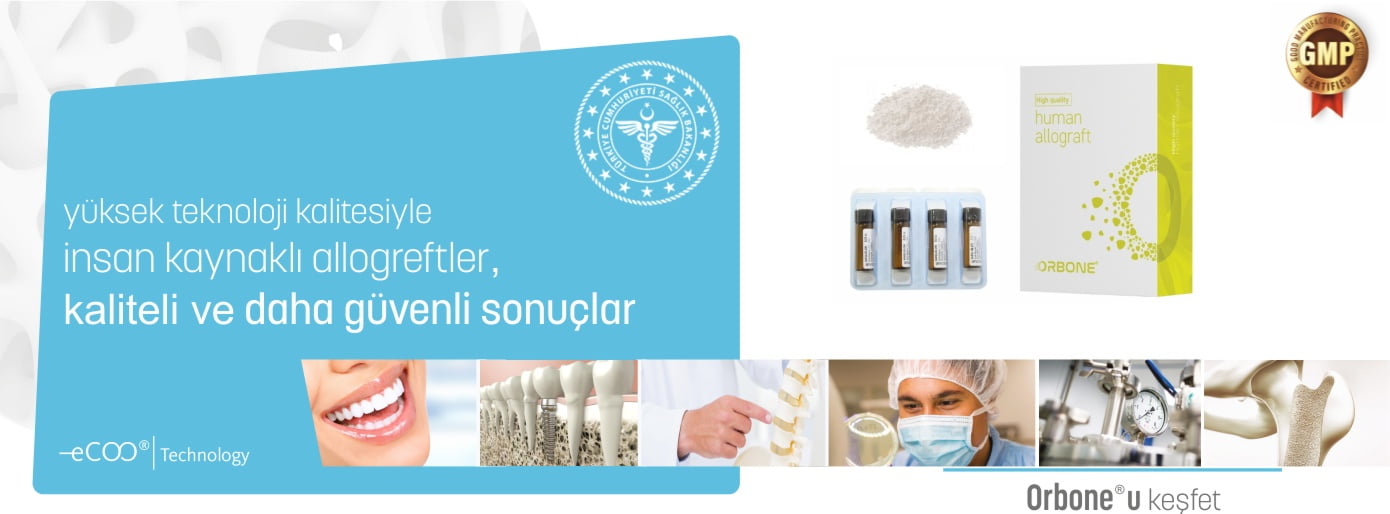ORBONE ALLOGRAFT USER MANUAL
READ THIS MANUAL CAREFULLY BEFORE USE
DESCRIPTION
Orbone® Allografts are donated human tissues obtained from the musculoskeletal system and sourced from accredited tissue banks compliant with European regulations. The manufacturing and distribution processes comply with EATCB guidelines, national regulations, and legal requirements.
The tissues are minimally processed into trabecular and cortical structures such as cancellous/cortical chips, powder, blocks, wedges, struts, and cylinders. Demineralized Bone Matrix (DBM) is produced from cortical bone.
All Orbone® allografts are devitalized using supercritical carbon dioxide (ScCO₂)-based eCOO® Technology. During this process, components that could trigger immune responses are removed while preserving the tissue structure.
Products are offered in frozen, lyophilized, or cold-chain preserved forms and sterilized by irradiation. The processing steps include deproteinization (ScCO₂), freezing, drying, and 25–40 kGy gamma sterilization. Each batch is microbiologically tested to confirm the absence of pathogens.
Orbone® allografts are available in various forms as shown in Table 1:
Table 1: Orbone® Allograft Types
| Product Name | Source Tissue |
| Orbone® Cancellous Chips | Cancellous Bone |
| Orbone® Cortical Chips | Cortical Bone |
| Orbone® Cortico-Cancellous Chips | Cortical + Cancellous Bone |
| Orbone® Femoral Head | Cancellous Bone |
| Orbone® Demineralized Bone Matrix (DBM) Types (Hydrated and Anhydrous) | Cortical Bone |
| Orbone® Structural Grafts | Cortical Bone |
INDICATIONS
Orbone® allografts are allogeneic graft materials used for the reconstruction of bone defects, compensation of bone loss, support of osteointegration, provision of skeletal support, and filling of osseous cavities.
These allografts are indicated for use in various surgical disciplines such as orthopedic surgery, traumatology, neurosurgery, oral and maxillofacial surgery, and are effective in providing osteoconductive and structural support.
Table 2 summarizes the indications for Orbone® allografts.
Table 2: Summary of Allograft Indications
| Product Name | Indications |
| Orbone® Cancellous Chips | Surgical indications requiring the use of osteoconductive scaffold or volumetric filler material for bone regeneration. |
| Orbone® Cortical Chips | |
| Orbone® Cortico-Cancellous Chips | |
| Orbone® Femoral Head | |
| Orbone® Demineralized Bone Matrix (DBM) Types (Hydrated and Anhydrous) | |
| Orbone® Structural Grafts | Orthopedic and surgical procedures where allograft use is indicated for bone reconstruction, regeneration, and mechanical stability. |
CONTRAINDICATIONS
The use of allografts is contraindicated in surgical implantation sites with active or latent infections. Additionally, their use is contraindicated in patients who, based on diagnosis and clinical evaluation by a specialist, are deemed unsuitable for bone grafting.
WARNINGS AND PRECAUTIONS
- Physicians applying Orbone® allograft products must carefully evaluate the patient’s medical history and ensure appropriate hygienic conditions and postoperative follow-up protocols.
- Active or latent infections present in the graft implantation area must be properly treated before implantation.
- DO NOT USE if the packaging or allograft material is damaged or if the label is missing.
- DO NOT USE the product after the expiration date indicated on the label.
- Only the inner packaging (sterile pouch or bottle) is sterile; do not place the outer packaging in sterile fields.
- Do NOT USE lyophilized (freeze-dried) allograft if it has been left for more than 24 hours after rehydration.
- DO NOT USE frozen allograft if it has not been used within 24 hours after thawing or if storage temperatures recommended have been exceeded. (See section “Frozen Bone and Soft Tissue”)
- Do NOT re-sterilize, autoclave, or disinfect the allograft by any other method before use. The product is sterilized by irradiation.
- The allograft is intended for single patient and single surgical procedure use only.
- Unused leftover material cannot be reused and must be disposed of according to medical waste regulations.
Use with Caution in the Following Conditions:
- Severe vascular or neurological disease
- Fever (febrile conditions)
- Uncontrolled diabetes mellitus
- Pregnancy
- Hypercalcemia
- Patients with renal impairment
- History of past or active Pott’s disease (vertebral tuberculosis)
- Presence of osteomyelitis at the surgical site
- Sepsis in or around the surgical site
- Incomplete skull development
- Patients unable to understand or comply with postoperative instructions
ADVERSE EFFECTS
The use of human-derived tissue (allograft) may cause the following adverse effects. These are not limited to the items below:
- Soft tissue and/or bone infection (osteomyelitis)
- Fever (febrile condition)
- Bone deformity at the application site
- Insufficient bone growth, delayed union, or non-union
- Fracture in the newly formed bone
- Risk of disease transmission and unwanted immune response
- Wound dehiscence due to incision line suture separation
- Local or systemic infection at the wound site
- Specific or non-specific immunological reactions
- Resorption, rejection, or necrosis of the allograft
DONOR SCREENING AND TESTING
Donor tissues undergo comprehensive medical, social, and laboratory screening to ensure safety. All donations are carried out in accordance with ethical principles and with informed consent from the donor or legal representative. Tissue procurement complies with the following regulations:
- European Directives: 2004/23/EC, 2006/17/EC, 2006/86/EC
- FDA Regulations: 21 CFR 1271 (U.S. Food and Drug Administration)
- World Health Organization Principles on Donation and Transplantation
- National and international tissue and cell regulations
Donor eligibility is determined based on medical and social history, physical assessment, cause of death, malignancies, infectious diseases, microbiological and serological tests, and risk factors for neurodegenerative diseases.
The following infectious agents have been tested and found negative:
- HIV-1/2 antibodies
- Hepatitis B surface antigen (HBsAg)
- Hepatitis B core antibody (anti-HBc)
- Hepatitis C antibody (anti-HCV)
- HTLV-I/II antibody
- Syphilis (RPR or VDRL)
- HIV-1 NAT (nucleic acid test)
- HCV NAT
- HBV NAT
The serological test kits used are FDA-approved and/or CE-marked under European medical device regulations and licensed by relevant regulatory authorities.
The donor’s medical suitability is evaluated based on all available data at the time of donation — medical history, laboratory results, physical examination findings, autopsy and forensic reports if applicable — according to current criteria. The donor was found suitable for tissue transplantation.
Viral Safety and Limitations
The processing of Orbone® allografts includes a supercritical carbon dioxide (ScCO₂)-based viral inactivation step. However, absolute protection against pathogens that cannot yet be detected with current technology cannot be guaranteed. Therefore, while all screening and processing procedures aim to minimize the risk of infectious diseases, residual infection risk associated with human-derived tissue use cannot be completely eliminated.
Immune Response and Reporting Obligations
Hypersensitivity or allergic reactions against Orbone® allografts have not been reported or detected in clinical studies to date. However, since these products contain proteins, proteoglycans, and other human tissue components, there is a theoretical potential for such reactions to occur.
Any adverse event or reaction believed to be related to allograft application should be reported promptly to the manufacturer or authorized distributor.
STORAGE CONDITIONS
Frozen allografts should be stored on dry ice or at temperatures between –40°C and –80°C.
Lyophilized (freeze-dried) allografts should be stored between 0°C and 40°C in a dry environment (see Table 3).
WARNINGS
⚠️ Do NOT store allograft packages in freezers at –90°C or lower, or in liquid nitrogen (vapor or liquid phase). This may compromise the biological integrity of the allograft.
⚠️ Thawed tissues must be used within 24 hours from the time of thawing. Unused allografts after this period must be disposed of according to medical waste protocols.
⚠️ Do not expose allografts to direct sunlight.
Table 3: Storage Conditions
| Product Name | Storage Conditions |
| Orbone® Cancellous Chips (Lyophilized) | 0°C – 40°C |
| Orbone® Cortical Chips (Lyophilized) | 0°C – 40°C |
| Orbone® Cortico-Cancellous Chips (Lyophilized) | 0°C – 40°C |
| Orbone® Femoral Head (Lyophilized) | 0°C – 40°C |
| Orbone® Femoral Head (Fresh Frozen) | (-40)°C – (-80)°C |
| Orbone® Demineralized Bone Matrix (DBM) Variants (Hydrated and Anhydrous) (Lyophilized) | 0°C – 40°C |
| Orbone® Structural Grafts (Lyophilized) | 0°C – 40°C |
| Orbone® Structural Grafts (Fresh Frozen) | (-40)°C – (-80)°C |
| Orbone® Soft Tissues (Lyophilized) | 0°C – 40°C |
| Orbone® Soft Tissues (Fresh Frozen) | (-40)°C – (-80)°C |
PREOPERATIVE PREPARATION
Proper preparation of the recipient bed is critical for successful allograft integration. There should be no infection present at the application site prior to grafting.
Where possible, securing the allograft stably to the host bone is important to support integration and prevent graft displacement.
LYOPHILIZED BONE, LYOPHILIZED DEMINERALIZED BONE, AND LYOPHILIZED SOFT TISSUE
Lyophilized bone, demineralized bone, and soft tissue grafts are preserved by lyophilization (freeze-drying) to a total water content of 5% or less.
Lyophilized Packaging Note:
Tissues preserved by lyophilization are packaged in nested PET-G screw-cap jars, glass bottles, or nested Tyvek sterilization pouches.
Reconstitution / Rehydration Procedure
- Before dental, oral, and maxillofacial surgery, standard preoperative antiseptic measures should be taken to prevent the transfer of oral flora bacteria to the surgical site; the risk of infection and inflammation should be minimized.
- Aseptic surgical protocols must be strictly followed before the operation.
- The allograft package should be opened in a sterile field and prepared according to relevant preparation procedures (rehydration, etc.).
- Structural allografts can be cut or shaped appropriately to fit the implantation site.
- The implantation site must be prepared to be suitable for grafting; it should be free of infection, well-vascularized, and contain viable tissue.
- The prepared allograft should be transferred to the implantation area under aseptic conditions.
- To optimize healing, the implantation site should be properly closed and protected.
- Unless clinically indicated due to infection or necrosis, the allograft should remain in place and not be removed after implantation.
- Further surgical intervention at the implantation site should be avoided until the healing process is complete.
- Allografts should be in contact with a well-vascularized host bed for optimal integration. Soft tissue trauma should be minimized.
- Allografts are not designed to provide primary structural support. Unless fully supported, avoid full weight bearing on the graft during healing.
WARNINGS:
⚠️Successful allograft integration requires direct contact with a well-vascularized implant bed.
⚠️Before implantation, it is recommended to prepare the allograft with sterile saline (0.9% NaCl), Lactated Ringer’s solution, or approved antibiotic solutions if needed.
⚠️Contact with any solutions other than those specified may damage the biological properties of the allograft and negatively affect its performance. Do not expose the graft to other chemicals or solutions.
⚠️ Presence of active or latent infection at the implantation site may lead to graft rejection and serious complications.
o Ensure there is no infection in the implant area before surgery.
o If infection is detected, it should be treated properly prior to implantation.
Preparation for Use
- Cancellous, Cortical, and Cortico-Cancellous Chip Grafts (Room Temperature)
These grafts should be rehydrated before implantation to regain their natural elasticity and provide optimal fit at the transplant site. The following preparation steps should be performed using aseptic techniques:
- Open the outer packaging and remove the graft with sterile forceps.
- Fully immerse the graft in sterile saline at room temperature, Lactated Ringer’s solution, or an equivalent solution.
- Optionally, the graft may be mixed with the patient’s autologous blood or bone marrow to enhance biological activity.
- If no known allergies exist, antibiotics may be added to the rehydration solution.
Rehydration times vary according to graft type:
- Femur and hemi-head pieces: ~30 minutes
- Blocks, strips, wedges, etc.: ~15 minutes
- Powder, particulate, and granule forms: a few minutes
- Demineralized Bone Matrix (DBM) Types (Room Temperature)
- Open the outer packaging and remove the inner sterile package (pouch, bottle, or syringe form).
- Disinfect the inner packaging with an alcohol-based surgical disinfectant spray and place it in the sterile surgical field.
- If the contents are to be mixed (e.g., with saline, Lactated Ringer’s, or autologous blood), transfer them to a sterile container before use.
- Structural Allografts (Room Temperature)
- Using aseptic technique, open the outer packaging and inner sterile pouch.
- Transfer the inner sterile pouch to the sterile surgical field.
- Remove the allograft from the inner pouch and prepare it for direct use.
- Place the graft into a sterile stainless steel container or bowl containing sterile saline or Lactated Ringer’s solution at 37°C ± 2°C and rehydrate for 30–60 minutes.
- If needed, appropriate antibiotics may be added to the solution.
FROZEN BONE AND FROZEN SOFT TISSUE
Frozen bone and soft tissue allografts are stored at temperatures ranging from -40°C to -90°C prior to shipment and are transported on dry ice.
Reconstitution / Rehydration Procedure
- Prior to dental, oral, and maxillofacial surgical procedures, standard preoperative antiseptic protocols should be rigorously applied to prevent bacterial contamination from the oral flora to the surgical site, thereby minimizing the risk of infection and inflammation.
- Strict aseptic surgical protocols must be adhered to before the operation.
- The allograft packaging should be opened in a sterile environment, and the allograft must be prepared according to the relevant preparation procedures such as rehydration.
- Structural allografts can be trimmed or shaped as required to fit the implantation site.
- The implantation site must be properly prepared, free from infection, well-vascularized, and contain viable tissue suitable for grafting.
- The prepared allograft should be transferred to the implantation site under aseptic conditions.
- To optimize healing, the implantation site should be carefully closed and protected.
- Unless clinical indications such as infection or necrosis arise, the allograft should remain in place and should not be removed once implanted.
- Additional surgical intervention at the implantation site should be avoided until the healing process is complete.
- Allografts require direct contact with a well-vascularized host bed for optimal integration; soft tissue trauma should be minimized.
- Allografts are not intended to provide primary structural support. Full weight-bearing on the graft during the healing phase should be avoided unless the graft is fully supported.
|
WARNINGS ⚠️ Successful integration of the allograft requires direct contact with a well-vascularized implant bed. ⚠️ Prior to implantation, it is recommended to prepare the allograft with sterile saline solution (0.9% NaCl), Lactated Ringer’s solution, or approved antibiotic solutions as needed. ⚠️ Exposure to any other solutions or chemicals may adversely affect the biological properties and performance of the allograft and must be avoided. ⚠️ Frozen allografts must never be thawed using a microwave oven, as this may damage the tissue’s structural integrity and compromise its effectiveness. ⚠️ Presence of active or latent infection at the implantation site may result in graft rejection and serious complications. o Ensure the implantation site is free of infection before surgery. o If infection is detected, appropriate treatment must be administered prior to implantation. ⚠️ Thawed tissue not used within 24 hours must be discarded. Unopened packages thawed for 2 hours or less may be refrozen. It is the responsibility of the transplant facility or clinician to maintain the tissue in recommended storage conditions prior to transplantation. |
Preparation for Use
Thawing Instructions
IMPORTANT: If the allograft is supplied frozen, it must be thawed at least 12 hours before implantation. Thawing should be carried out in a refrigerator maintained at 2°C to 8°C.
➤ Transfer the package directly from the deep freezer to the refrigerator without opening.
IMPORTANT: For faster thawing, sterile irrigation solutions (e.g., saline or Lactated Ringer’s solution) may be warmed up to a maximum temperature of 37°C under controlled and aseptic conditions.
| ⚠️ WARNING: Do not use a microwave oven to thaw the allograft, as this may irreversibly damage its biological structure and function. |
- Structural Allografts (2°C – 8°C)
- Using aseptic technique, open the outer packaging and remove the inner sterile pouch.
- Transfer the inner sterile pouch to the sterile surgical field.
- Remove the allograft from the inner pouch and prepare it for immediate use.
- Place the graft in a sterile stainless steel container or bowl containing sterile saline or Lactated Ringer’s solution at 37°C ± 2°C, and allow it to rehydrate for 30 to 60 minutes.
- If indicated, appropriate antibiotics may be added to the rehydration solution.
TRACEABILITY / PATIENT FOLLOW-UP
To comply with legal regulations related to human tissue-derived products, traceability is mandatory for all Orbone® allograft applications.
- After each allograft implantation, the Allograft Follow-up Form must be completed accurately and thoroughly.
- These records enable traceability of the allograft back to its source and are critical for fulfilling legal and clinical responsibilities in monitoring potential adverse events.
- The completed forms must be returned to the accredited tissue-providing institution according to the instructions on the form and within the specified timeframe.
- Full compliance with data privacy and personal data protection regulations (e.g., GDPR or applicable national data protection laws) must be ensured.
➡️ It is the user’s responsibility to complete and return the follow-up form, which is essential for both product safety and regulatory compliance.
COMMUNICATION AND REPORTING
If you have any questions, concerns, or require technical support regarding the product, please contact your local tissue bank, official distributor, or the supplier from whom you obtained the product.
Furthermore, any adverse events, complications, or unexpected effects occurring during or after the use of Orbone® allografts must be reported immediately to the relevant authorities. Reporting such incidents is critical to ensuring patient safety and maintaining continuous product traceability.
➡️ When submitting reports, please provide complete product information, lot number, and any clinical details related to the incident.
LEGAL STATUS
The use of allografts is subject to legislation governing human tissues and cells (e.g., EU Directives 2004/23/EC, 2006/17/EC, 2006/86/EC; U.S. FDA 21 CFR 1270 & 1271), tissue banking standards, and international regulations.
To minimize the risk of disease transmission from donor tissue, donor screening and laboratory testing are conducted, followed by viral inactivation using supercritical carbon dioxide (ScCO₂) technology.
There are currently no long-term studies available evaluating the carcinogenic, mutagenic, or reproductive health effects of bone allografts in clinical use.
CAUTION: Usage Restriction
⚠️ Warning: This product is restricted to use by physicians, dentists, and/or podiatrists only.
Note: Human tissues intended for transplantation may not be supplied, distributed, or made available for veterinary medical use.
This restriction arises from the necessity to limit the use of human tissue-derived transplant products exclusively to clinical applications in human health and within the framework of applicable legal regulations.




